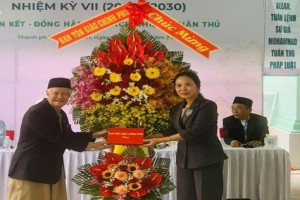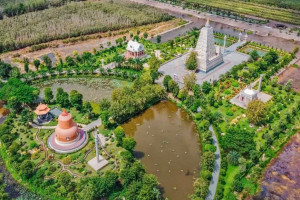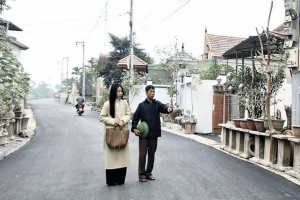
Percent of Asian American Adults Identifying as Buddhist in Decline According to New Study
10/17/2023
A study conducted by the Pew Research Center released 11 October reveals an evolving landscape of Buddhist adherence among Asian American adults. The research, comparing data from 2012 and 2023, shows that while the number of Asian American adults formally identifying as Buddhists has seen a slight decline, a significant proportion still maintains a strong connection to Buddhist culture and heritage.

Hsi Lai Temple in Hacienda Heights, CA. From wikimedia.org
The study, which followed over 7,000 participants over the course of a year, found that Asian Americans are part of the growing demographic of Americans known as “nones,” claiming no particular religious affiliation. For instance, in 2012, 26 per cent of Asian Americans identified as having no religion, whereas in 2023 that number has risen to 32 per cent.

From pewresearch.org
Researchers caution readers from over-interpreting the results of surveys like this, as they are often based in Judeo-Christian frameworks of what counts as religion and religious practice.
Interviews after the 2012 study, Sharon Suh, a Buddhism scholar and chair of the Department of Theology and Religious Studies at Seattle University, noted that, “This is one of those classic apples to oranges questions: How do you ask about God in a tradition that has no Creator-God? Asian-American Buddhists practice their religion in very different ways — it’s not always how frequently one prays.” (The Washington Post)
In 2012, 14 per cent of Asian American adults claimed Buddhism as their religion. However, this year the figure has decreased to 11 per cent. 21 per cent of respondents in the 2023 study said they feel closely connected to Buddhism for reasons such as ancestry or culture, despite not formally identifying as Buddhists. This accounts for a total of one-third of Asian Americans expressing some level of connection to Buddhism.
A deeper examination of the data reveals notable differences among specific Asian American subgroups. For example, individuals of Southeast Asian origin, including Vietnamese Americans and those with heritage in other Southeast Asian countries, exhibit a stronger tendency to identify as Buddhists. A substantial 37 per cent of Vietnamese Americans and 38 per cent of those with roots in non-Vietnamese and non-Philippine Southeast Asian nations embrace Buddhism as their religion.
In contrast, among East Asian origin groups such as Chinese, Japanese, and Korean Americans, a majority who feel connected to Buddhism do not formally identify as Buddhists. Instead, they er describe their connection as feeling “close to” Buddhism apart from religious identification. However, Southeast Asian respondents do not follow this pattern. (Pew Research Center)

From pewresearch.org
For instance, while 62 per cent of both Vietnamese and Japanese Americans express some level of connection to Buddhism, only 19 per cent of Japanese Americans formally identify as Buddhists. A notable 30 per cent of Japanese Americans do not align with any religion but feel an affinity with Buddhism for cultural or ancestral reasons. Another 12 per cent identify with a religion other than Buddhism but maintain a cultural connection to Buddhism.
The study also examined the role of religion in the lives of Asian American Buddhists. Approximately 31 per cent of those identifying as Buddhists consider religion to be very important in their lives, with an additional 40 per cent indicating that it is somewhat important. Interestingly, attending religious services monthly is less common (17 per cent) among Buddhists than the use of home altars, shrines, or religious symbols for worship (63 per cent).
This distinction is even more pronounced among Buddhists who place great importance on their religious practice. Roughly 32 per cent of this group attend religious services at least monthly, while a significant 86 per cent incorporate a shrine, altar, or religious symbol into their home worship. In contrast, among all Asian Americans who highly value religion in their lives, there is a smaller gap between the percentage attending religious services at least monthly (65 per cent) and those using home altars or shrines for worship (55 per cent).
Asian American Buddhists are distinctive in various aspects. They report a lower percentage of friends who share their religion compared to Asian Americans overall (21 per cent vs. 30 per cent). Furthermore, they constitute the oldest demographic within major religious groups, with 50 per cent aged 50 or older. Interestingly, 20 per cent of Asian American Buddhists were born in the United States, a slightly smaller figure when compared to the general Asian American population, where 32 per cent were born in the United States.
This study provides valuable insights into the evolving landscape of Buddhism within the Asian American community, emphasizing the significance of cultural and ancestral connections to the tradition, even as formal religious identification undergoes changes.
Source: buddhistdoor.net/Justin Whitaker




